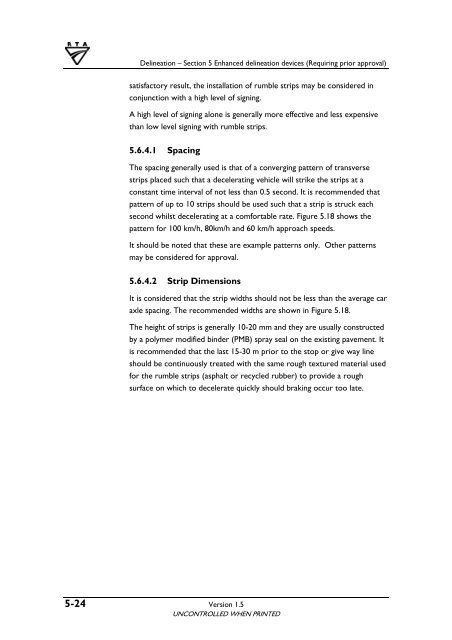Requiring prior approval - RTA
Requiring prior approval - RTA Requiring prior approval - RTA
Delineation – Section 5 Enhanced delineation devices (Requiring prior approval) satisfactory result, the installation of rumble strips may be considered in conjunction with a high level of signing. A high level of signing alone is generally more effective and less expensive than low level signing with rumble strips. 5.6.4.1 Spacing The spacing generally used is that of a converging pattern of transverse strips placed such that a decelerating vehicle will strike the strips at a constant time interval of not less than 0.5 second. It is recommended that pattern of up to 10 strips should be used such that a strip is struck each second whilst decelerating at a comfortable rate. Figure 5.18 shows the pattern for 100 km/h, 80km/h and 60 km/h approach speeds. It should be noted that these are example patterns only. Other patterns may be considered for approval. 5.6.4.2 Strip Dimensions It is considered that the strip widths should not be less than the average car axle spacing. The recommended widths are shown in Figure 5.18. The height of strips is generally 10-20 mm and they are usually constructed by a polymer modified binder (PMB) spray seal on the existing pavement. It is recommended that the last 15-30 m prior to the stop or give way line should be continuously treated with the same rough textured material used for the rumble strips (asphalt or recycled rubber) to provide a rough surface on which to decelerate quickly should braking occur too late. 5-24 Version 1.5 UNCONTROLLED WHEN PRINTED
Delineation – Section 5 Enhanced delineation devices (Requiring prior approval) Figure 5.18: Recommended rumble strip pattern on intersection approach for ≥100 km/h approach speed Notes – (i) Figure shown is for ≥100 km/h approach speed environment (ii) For
- Page 1 and 2: Delineation Section 5 - Enhanced de
- Page 3 and 4: Delineation Section 5 ENHANCED DELI
- Page 5 and 6: Delineation - Section 5 Enhanced de
- Page 7 and 8: Delineation - Section 5 Enhanced de
- Page 9 and 10: Delineation - Section 5 Enhanced de
- Page 11 and 12: Delineation - Section 5 Enhanced de
- Page 13 and 14: Delineation - Section 5 Enhanced de
- Page 15 and 16: Delineation - Section 5 Enhanced de
- Page 17 and 18: Delineation - Section 5 Enhanced de
- Page 19 and 20: 6 0 m m 2 50 m m Delineation - Sect
- Page 21 and 22: Delineation - Section 5 Enhanced de
- Page 23 and 24: Delineation - Section 5 Enhanced de
- Page 25 and 26: Delineation - Section 5 Enhanced de
- Page 27 and 28: Delineation - Section 5 Enhanced de
- Page 29 and 30: Delineation - Section 5 Enhanced de
- Page 31: Delineation - Section 5 Enhanced de
- Page 35 and 36: Delineation - Section 5 Enhanced de
- Page 37 and 38: [Inside rear cover - provided for d
Delineation – Section 5 Enhanced delineation devices (<strong>Requiring</strong> <strong>prior</strong> <strong>approval</strong>)<br />
satisfactory result, the installation of rumble strips may be considered in<br />
conjunction with a high level of signing.<br />
A high level of signing alone is generally more effective and less expensive<br />
than low level signing with rumble strips.<br />
5.6.4.1 Spacing<br />
The spacing generally used is that of a converging pattern of transverse<br />
strips placed such that a decelerating vehicle will strike the strips at a<br />
constant time interval of not less than 0.5 second. It is recommended that<br />
pattern of up to 10 strips should be used such that a strip is struck each<br />
second whilst decelerating at a comfortable rate. Figure 5.18 shows the<br />
pattern for 100 km/h, 80km/h and 60 km/h approach speeds.<br />
It should be noted that these are example patterns only. Other patterns<br />
may be considered for <strong>approval</strong>.<br />
5.6.4.2 Strip Dimensions<br />
It is considered that the strip widths should not be less than the average car<br />
axle spacing. The recommended widths are shown in Figure 5.18.<br />
The height of strips is generally 10-20 mm and they are usually constructed<br />
by a polymer modified binder (PMB) spray seal on the existing pavement. It<br />
is recommended that the last 15-30 m <strong>prior</strong> to the stop or give way line<br />
should be continuously treated with the same rough textured material used<br />
for the rumble strips (asphalt or recycled rubber) to provide a rough<br />
surface on which to decelerate quickly should braking occur too late.<br />
5-24 Version 1.5<br />
UNCONTROLLED WHEN PRINTED



